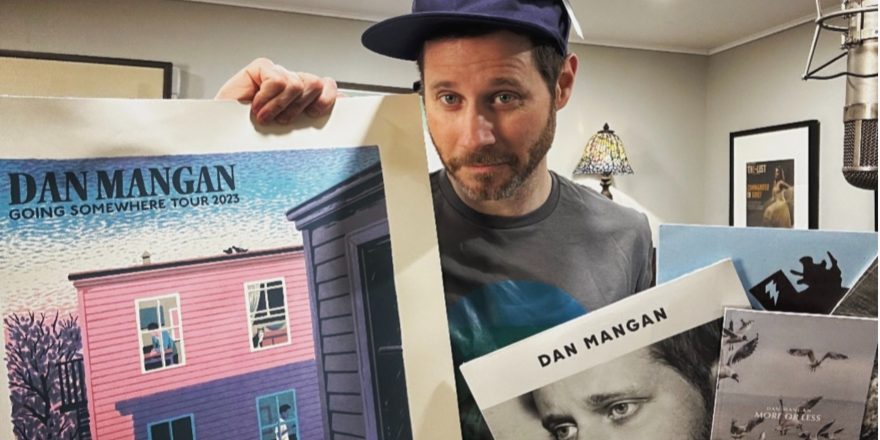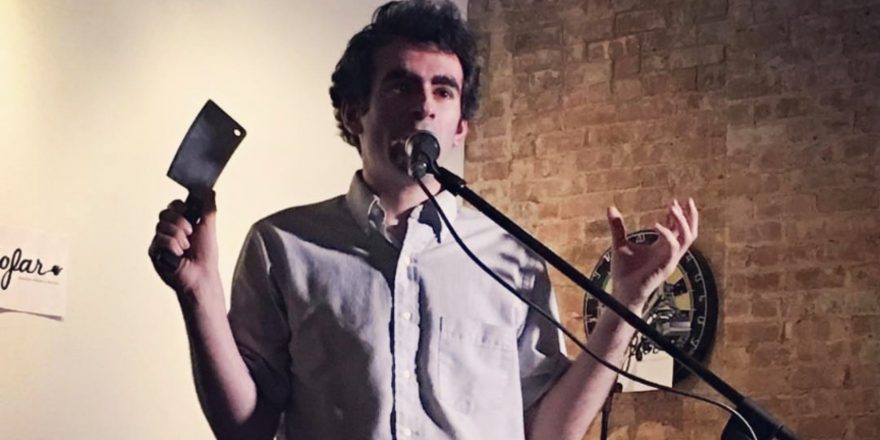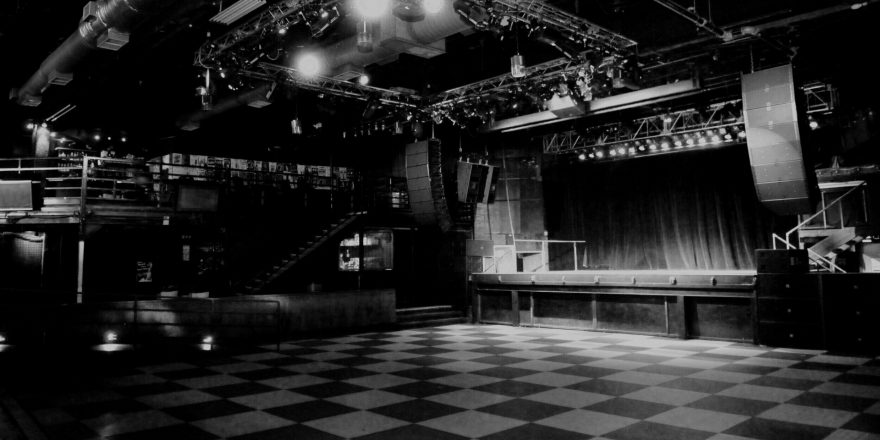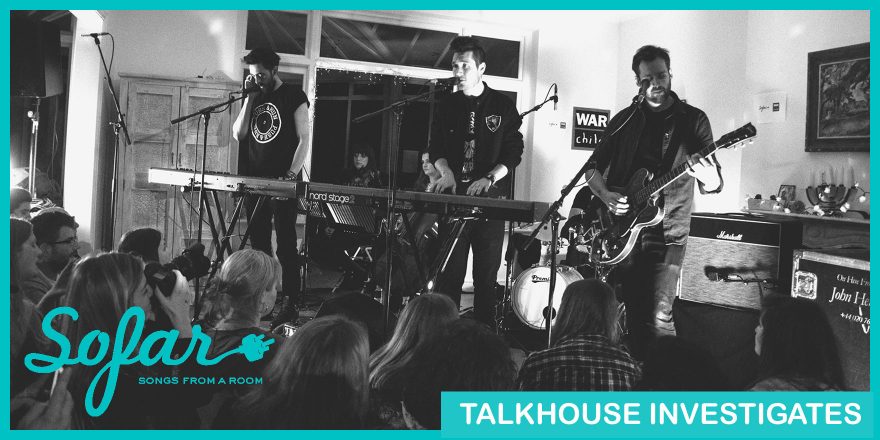“Merch cuts” are a largely accepted practice within the music industry, and have been a thorn in my side for as long as I’ve been touring. Profit margins have narrowed intensely in recent years, and if you’re an indie music fan, you may have noticed that touring musicians have been protesting merch cuts much more publicly.
When I posted about my frustration with merch cuts on Instagram last year, the resounding response from music fans was (and I paraphrase): “I had no idea this existed, and it’s bullshit.”
So what exactly are they? And how did they become so common? Let’s unpack it.
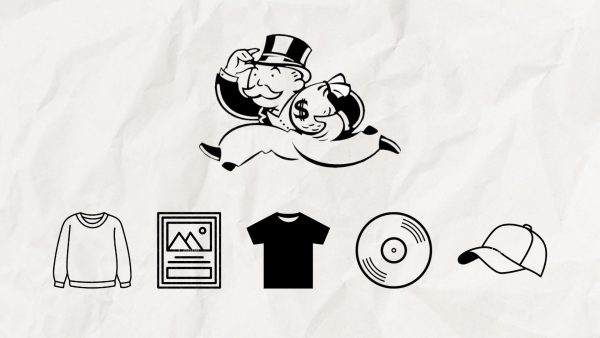
What are merch cuts?
For most middle class touring artists (i.e., the ones who can tour and make a living playing small-to-mid-sized clubs and theaters), income from merchandise is a crucial part of their business. Venues all over North America (and some in Europe) charge artists a commission on the merch sold at concerts. These commissions generally range from 10-35% of sales.
Sometimes there are different commission rates applied to different types of merch:
- Hard merch, which refers to music (i.e. CDs or LPs purchased wholesale from record labels), is usually commissioned at lower rates because it has tighter profit margins.
- Soft merch, which refers to everything else (i.e. t-shirts, sweaters, hats, posters, etc.), is often commissioned at higher rates because of capitalism.

What is the rationale for merch cuts?
The most frequent rationale given is that the venue is providing a retail space — like a pop-up shop. This would make sense if the venue were sharing bar sales with the artist, because by that same rationale, the artist is the one providing the patrons to the venue. As it turns out, venue owners would sooner eat a urinal puck than pay artists a booze commission.
Another argument given is that the venue is providing infrastructure to help the artist sell merch. To wildly varying degrees, this is somewhat valid. Though many clubs point you toward a dimly lit and hard to access corner, some have invested in handy overhead lights and metal display racks.
My opinion is that having a half-decent merch area is a low hanging requirement of being a venue at all — especially considering that the artist and promoter are already paying the venue a rental fee for use of the space. If I’m renting an apartment, I’d hope I don’t have to pay extra to use the restroom.
It’s important to clarify that there are some instances where merch commissions are totally warranted. Some music festivals actually provide a lot to artists — they’ll count in the merch, manage inventory, build a tented storefront, staff it over the course of several days and provide a point-of-sale (POS) system to take transactions. In this case, the festival is providing a crucial service that the artists would have a hard time managing themselves, and charging a commission for that work is more than fair.
The main point of contention for merch cuts has to do with the clubs and theaters where artists perform on tour. This is where the majority of artists do the majority of their business.
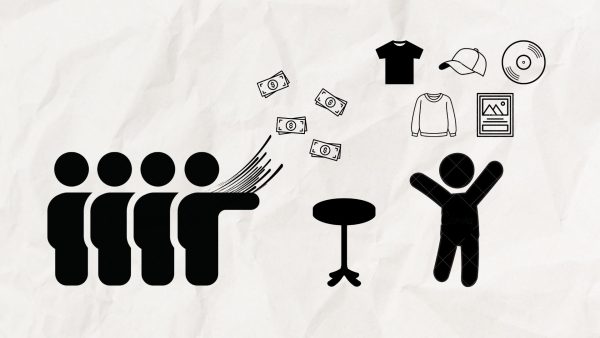
Who actually sells the merch, and who pays for that labor?
Most often, the artist pays someone out of pocket to sell merch. Usually, if this person is not already on tour with the band, they are sourced locally by the promoter or venue. The cost for these services tends to range from $75-$200, or $20-$25 / hour.
Let’s be clear that paying people fairly for their labor is crucial and not the issue being debated here.
Sometimes, particularly in larger civic theaters where they have armies of retiree volunteers on hand, the venue will supply a merch seller. Almost invariably, these venues will take a commission in return for this provided labor (which, at a percentage of sales, can amount to 5-10x the cost of just hiring someone out of pocket as mentioned above).
POS systems used to be expensive to acquire and tied to venue box offices, which made this whole process even more convoluted. These days, apps like Square have made it easier for artists to tour with their own credit & debit card processing solutions.
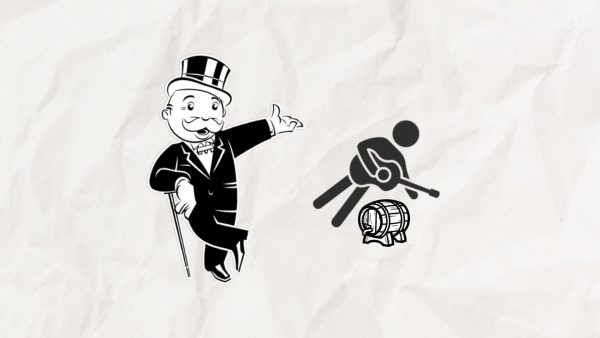
How did merch cuts become a thing?
Before I break this down, it’s worth noting… larger promoters may also own the venue and the ticketing company (or perhaps even the management and/or booking agency), so the double/triple/quadruple dipping creates many points of potentially conflicted interest. For the sake of clarity, I’m going to lay it out as if all of the involved parties (artists, promoters, venues, agents) are separate entities.
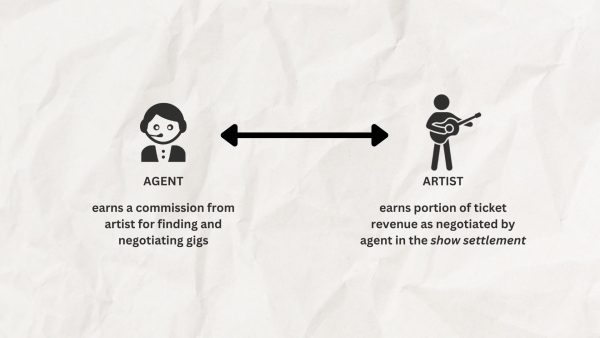
Artists are represented by agents. In exchange for finding shows and negotiating deals, agents charge artists a commission (usually 10%) against the artist’s portion of earnings reflected in the show settlement.
Show settlements vary in complexity, but essentially, they tally the costs associated with the production & marketing of a show, weigh it against the ticket revenue, and then (fingers crossed) split the profit between the artist and promoter.
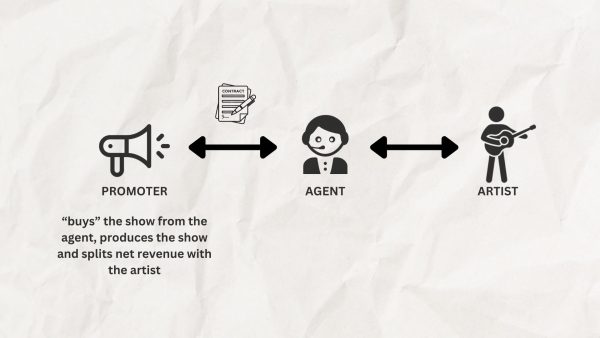
Agents work out deals for shows with promoters who “buy” the show. Most often, promoters incur some risk by providing a guaranteed fee for the artist, which would be paid out regardless of whether the show sells enough tickets to break even or makes a profit (referred to as “getting into points”).
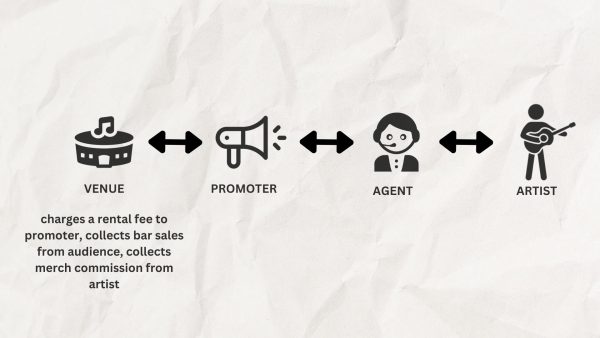
Promoters sell the tickets and rent the venue, and the rental fee is represented as a cost against the show settlement.
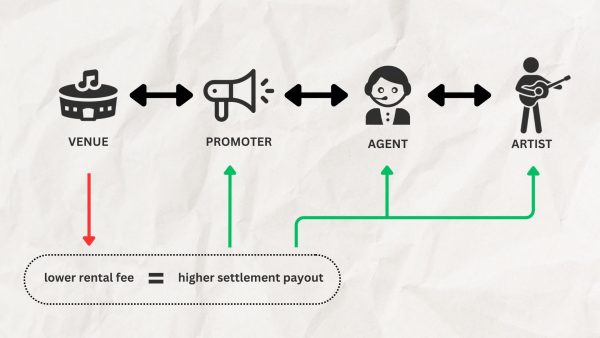
So the lower the venue rental fee, the lower the costs against the show, the higher the payout in the settlement. Promoters’ and agents’ earnings are directly related to the big juicy number at the bottom of the settlement, so they are incentivized to keep costs low.
Simultaneously, venues are all competing for the promoters’ business, so it’s also in their best interest to keep their rental costs low.
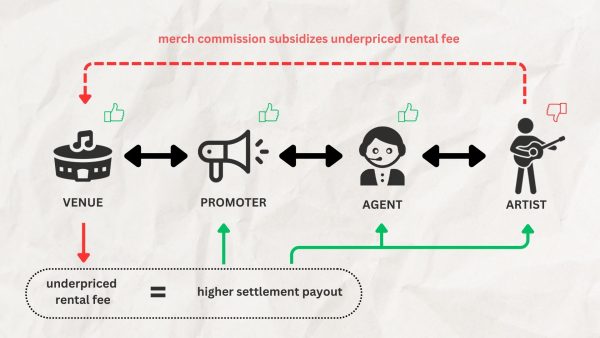
With increasing fervor, venues began underpricing their rental fees for a competitive edge with promoters, and then made up the difference by charging a merch commission directly to the artists on the night of the show. The agents and promoters (who are the ones writing the contracts) are perfectly happy to accept this arrangement because these added merch fees don’t touch the show settlement.
It’s a sneaky workaround to get the show off the ground, maximize settlement profit, and once again, the artist foots the bill.
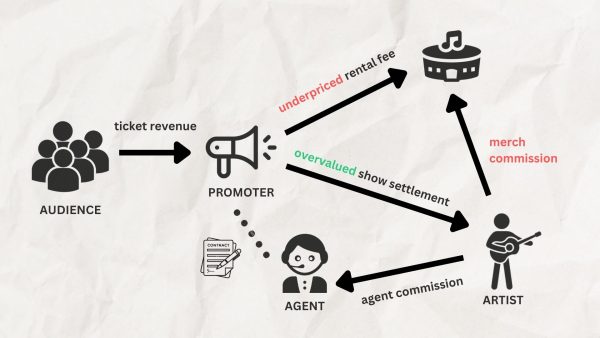
In short, after fronting the costs to design, manufacture, freight and sell merch, artists are also expected to cough up a commission to subsidize the competitive edge and bottom lines of venues, promoters and agents. Merch cuts create friction and incentivize dishonesty between partners who should be working together with shared risk, shared benefit and mutual victory.
I want to be very clear that these people are not evil. I’ve worked with countless venues, promoters and agents over the years, and save for a small handful of bozos, they’re hard-working, friendly, music-loving folks just trying to survive in a wildly volatile and risk-laden industry. Most of them actually dislike merch cuts in principle, but continue with them simply because it has become the norm.
Let’s call this an incremental slippery slope of normalizing an unfair status quo. The margins are tight for everyone involved. They’re all just trying to keep afloat, and artists aren’t generally known for their savvy with fine print.
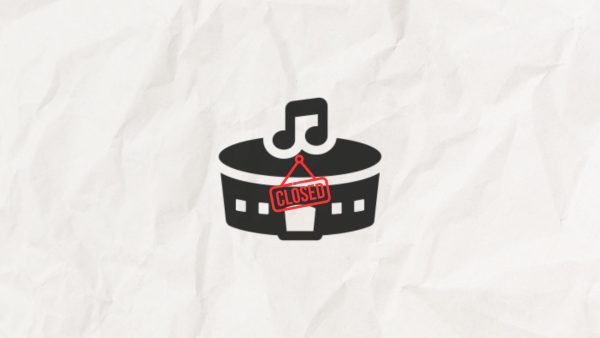
Won’t nuking merch cuts just put venues out of business?
Obviously, artists want venues to stay in business. Running a venue is expensive and complicated, and venues need to be fairly compensated for the services they provide. Another issue to tackle is that this entire industry has relied on bar sales to carry venues since forever, and alcohol sales are down everywhere because Gen Zs and Millennials don’t get smashed as regularly as their predecessors did.
The issue is not that venues need to make money. The issue is how they make money. And one thing is clear: if venues are facing a revenue crisis, artists are being disproportionately asked to carry the weight of that overhead — artists who already sustain huge risk in order to tour in the first place.
Everyone else gets paid before the person whose name is on the ticket — promoters, agents, venues, vehicle rentals, airlines, managers, crew, drivers, hotels, gear rental, auxiliary musicians, gas stations, yada yada yada — artists carry chaotic levels of overhead and just pray that there’s money left over at the end.
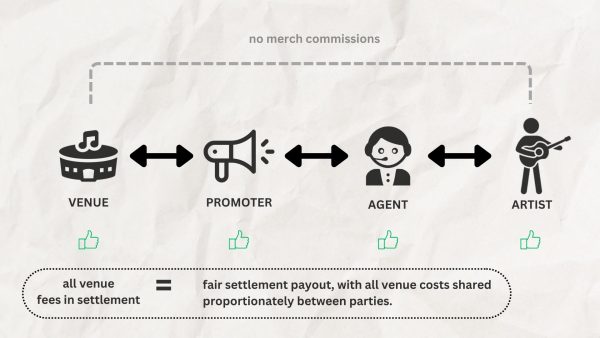
What’s the solution?
Merch fees should be nuked. If the venue rental fee does not cover the expenses of operation, or if removing merch cuts breaks a venue’s business model, then their rental rate is too low. In some cases, venues may need to raise the cost of their rental.
Then the actual overhead of the venue is shared fairly by the promoters, agents and artists. The show settlement more accurately reflects the real costs against the show, and the burden is proportionately felt by all parties.
An alternative solution is to calculate a fair merch commission, but then mark it as a cost right in the show settlement, rather than a direct cost from the venue to the artist. In this case, agents and promoters would also feel the burden of these commissions and would be incentivized to negotiate them down.
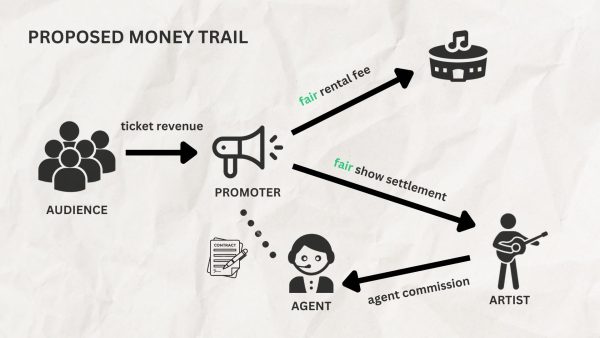
By either process, agents would be properly acting in the best interests of the artists they’re working for, which is exactly their job. And if enough agents insist upon it, then promoters and venues will play ball.
Eliminating merch cuts won’t really affect the Beyoncés or Taylor Swifts of the world, but it will help foster a thriving and exciting middle class of artistry and make touring more feasible for the rest of us.
Touring acts aren’t against paying a fair rate for services; they’re against spending weeks away from their families, selling plenty of tickets, and still losing money because the industry norms are crippling.
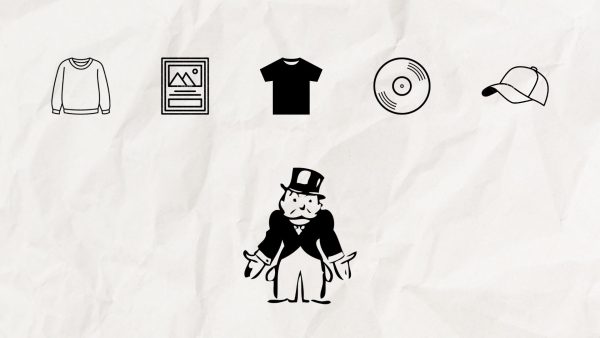
Is merch expensive to make?
Yes. It’s expensive to hire designers to design it, it’s expensive to manufacture and it’s expensive to freight it around the world.
CDs and LPs cost $7-20 wholesale from labels. Beyond the cost to design them, t-shirts can cost anywhere from $8-20 to manufacture, whereas sweaters can be as much as $20-40. Silk-screened posters are often $8-15 to print and hats are $12-20.
On a recent tour, we sold songbooks. After paying an orchestrator to arrange it, a designer to design it, and a publisher to manufacture it, they cost ballpark $30 to produce. We marked them up to $45, and they sold very well, but I did the math and realized that after a 20% venue commission, the venue was making $9, and I was taking home $4. Maybe we should have charged more to compensate for the commission, but I don’t like gouging fans just because the industry is broken. Presuming there was no commission, I was more than happy with a $15 markup on the item.
Oh, and after everything I’ve mentioned in this tirade, artists also often have to pay 5-20% commissions to their managers on their net merch sales.
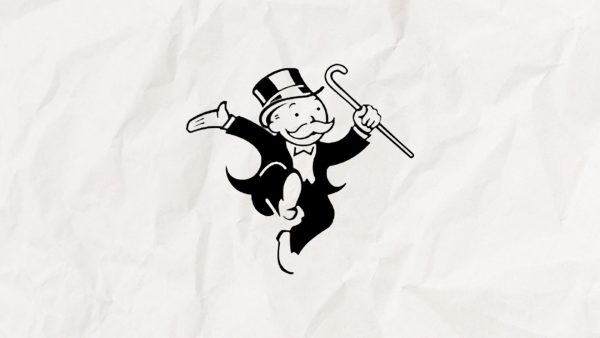
In conclusion
I don’t like artists complaining that it’s hard to be an artist. If this was easy, literally everyone would do it because it’s the best job in the world. But I will always advocate against unjust systems, and this just happens to be an unjust system with which I have a lot of experience (aka raging opinions).
I love my agents, my managers, the promoters and venues I work with, and I believe that everyone involved wants to find a more equitable solution — if for no other reason than to temper the outrage artists are voicing about merch cuts and venues on social media.
Shout out to my pal Cadence Weapon who has been on this for ages and helped convince over 200 venues and festivals to say no to merch cuts through his #MyMerch campaign in collaboration with the UMAW and FAC.
What’s dumb is that the solution is so very easy and has taken so very long to arrive. As I said above, if agents demand a more equitable situation for artists, then the promoters and the venues will fall in line. And agents will only do so if their artists insist upon it. So — frustrated indie artists who have made it this far into my rant… feel free to send this to your agent. And if you don’t have an agent, go book yourself a show on Side Door.


